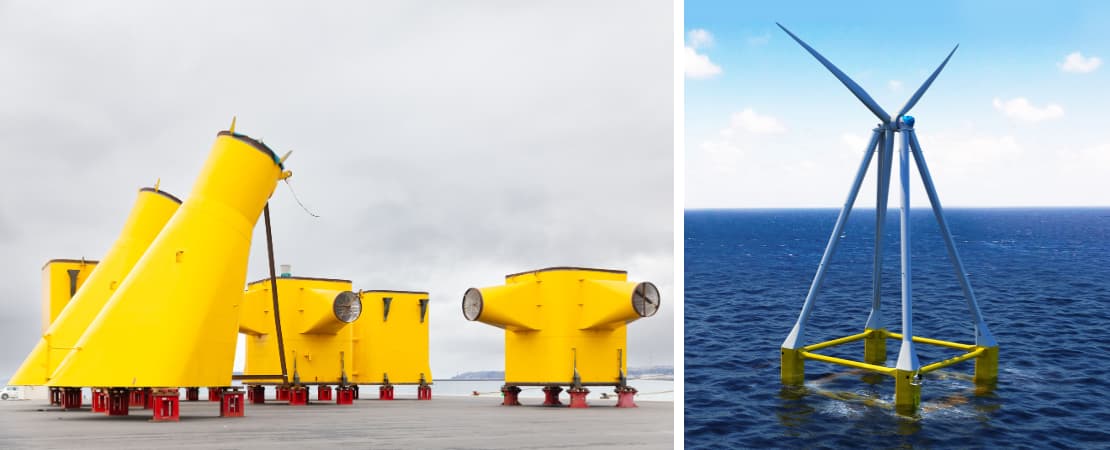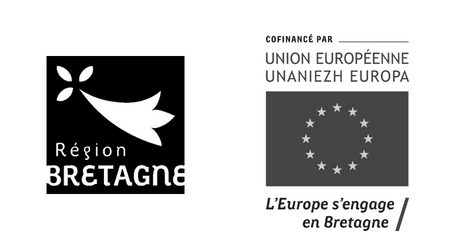Founded by Marc Guyot in 2015, Eolink has asserted itself, ten years on, as one of Brittany’s leading lights in the development of floating wind power. The firm chose Brest’s port for the assembly of its 5MW pyramid-shaped demonstrator. Once the assembly process is complete, it will be taken to the SEM-REV site off Croisic for testing. We talked to Engineering Team Lead Rudy Vanholme, Project Manager Xavier Piot, and Chief Commercial Officer Alain Morry.
Can you fill us in on the story behind Eolink?
Rudy Vanholme: Eolink was founded in 2015 by Marc Guyot, who filed the first patent for our pyramid-shaped structure and its floating wind concept. He started off by conducting tests a 1:50 scale model in Ifremer’s test tank, followed by a 1:10 scale model, then, in 2019, this prototype was connected to the EDF grid in the Brest roadsted, at the Sainte-Anne-du-Portzic test site. These tests validated the concept and he decided to pursue the project, aiming to build the 5MW demonstrator we’re working on today. We’re hoping to deploy it at the SEM-REV site in the coming years and perform a first near full-scale demonstration, so that we can deploy our solution on future floating wind farms in the years to come.
Xavier Piot: Eolink has two main shareholders: Spanish firm Acciona and French-based Valorem, which is involved with the 5MW demonstrator, particularly in the refurbishment of the turbine and blades that will be installed on top of the prototype’s tower. We have a team of around thirty employees.
What stage are you at in assembling the demonstrator in Brest’s port?
R.V.: The construction of the blocks began in July 2023 in China. During this construction phase, we decided to complete the assembly process in Brest. In late December, the blocks were unloaded in the port. Today, they are sitting on various base elements on the Polder and we prepare the assembly of these elements.
X.P.: Today, the demonstrator has a 52 m by 52 m base and a hub height of 100 m. The rotor diameter is exactly 115 m. So in fact, when we talk about a 15 MW or 20 MW turbine, or even larger projects, we’re looking at a 250 to 300 metre rotor diameter. And we’re reaching heights where we’ll be more like 300 metres high.
What are the main differences between your demonstrator and those of your competitors?
X.P.: The answer is quite straightforward: the number of towers. Most of our competitors use a single tower design. Our demonstrator has 4. So the forces are better distributed, meaning that our float can be smaller and lighter. We’re working on other designs, but the principle remains the same.
R.V.: As a general rule, the upper part of the wind turbine (the nacelle) rotates around its foundation, which is fixed in relation to the ground, as in the case of onshore or offshore wind turbines. For Eolink, the turbine remains attached to the pyramid-shaped foundation, and it is the turbine/foundation assembly that rotates around a point of rotation and is easily and passively oriented towards the wind. In addition, Eolink is preparing to industrialise its solution by using shipbuilding techniques, with modules made of very thin flat steel panels that are easy to cut and weld.
When can you expect to see this demonstrator reach industrialisation?
X.P.:One of the challenges facing the industrial deployment of floating wind turbines is the ability to produce massive structures in a short space of time and with significant space constraints in ports. Today, we can rely on feedback from our 5 MW unit and our interactions with the Port of Brest to come up with an optimised 15-20 MW design.
A.M.:Eolink’s ambition is to be ready for the deployment of commercial farms as early as 2030.
How does Eolink benefit from being based in Brittany?
X.P.: Brittany, and the Brest area in particular, boast a very strong fabric of maritime-related expertise. It is home to Ifremer and France Énergies Marines, two organisations we work closely with. Marc Guyot was keen for us to be based in Brest, in particular given the port’s capacity to meet industrial needs. Together with Saint-Nazaire, these two ports are in a league of their own.
R.V.: Brest is an excellent location for bidding in French tenders relating to the Atlantic coast. For instance, the AO5 call for Belle-Île-en-Mer comes to mind. We’re a long way from the Mediterranean, but the British Isles are readily accessible, just across the Channel. We can transport wind turbines either by simple towing or with semi-submersible vessels.
In terms of dry docks, Brest’s dry dock no.3 is one of the largest in Europe. The Port of Brest is investing massively in the development of its infrastructure to support the deployment of this new sector. So that brings added value. It has also been a driving force. I think Marc Guyot sensed this impetus that we want to promote and exploit to the full.
A.M.: There is also the fact that Bretagne Ocean Power brings SMEs into the spotlight and put them in contact with major groups through various efforts: pitching during events, networking sessions, communication on social media, etc. Opportunities are centralised through this network, which is useful for us in obtaining the relevant information. Bretagne Ocean Power is well known to contracting parties, so it is a reliable source of information.

